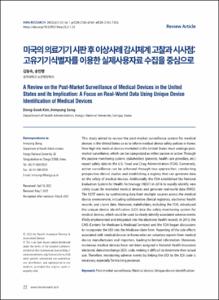미국의 의료기기 시판 후 이상사례 감시체계 고찰과 시사점: 고유기기식별자를 이용한 실제사용자료 수집을 중심으로
- Type
- Review Article
- Issued Date
- 2023-05-31
- Abstract
- This study aimed to review the post-market surveillance system for medical devices in the United States so as to inform medical device safety policies in Korea. New high-risk medical devices marketed in the United States must undergo postmarket surveillance, which can be categorized as either passive or active. Through the passive monitoring system, stakeholders (patients, health care providers, etc.) report safety data to the U.S. Food and Drug Administration (FDA). Conversely, active surveillance can be achieved through two approaches: conducting prospective clinical studies and establishing a registry that can generate data on the safety of medical devices. Additionally, the FDA established the National
Evaluation System for Health Technology (NEST) in 2016 to rapidly identify new safety issues for marketed medical devices and generate real-world data (RWD). The NEST works by synthesizing data from multiple sources across the medical device environment, including collaborative clinical registries, electronic health records, and claims data. Moreover, stakeholders, including the FDA, introduced the unique device identification (UDI) into the safety monitoring system for medical devices, which could be used to clearly identify associated adverse events if fully implemented and integrated into the electronic health records. In 2013, the CMS (Centers for Medicare & Medicaid Services) and the FDA began discussions to incorporate the UDI into the Medicare claim form. Reporting of the side effects associated with medical devices in Korea relies on voluntary reports from medical device manufacturers and importers, leading to limited information. Moreover, numerous medical devices have not been assigned a National Health Insurance electronic data interchange (EDI) code, making it difficult to determine their actual use. Therefore, monitoring adverse events by linking the UDI to the EDI code is necessary, especially for tracking purposes.
- Publisher
- 심사평가연구소
- Alternative Title
- A Review on the Post-Market Surveillance of Medical Devices in the United States and its Implication: A Focus on Real-World Data Using Unique Device Identification of Medical Devices
- Publisher
- 심사평가연구소
- Location
- KOR
- Citation
- 김동숙. (2023-05-31). 미국의 의료기기 시판 후 이상사례 감시체계 고찰과 시사점: 고유기기식별자를 이용한 실제사용자료 수집을 중심으로. HIRA Research, 3(1), 22–36. doi: 10.52937/hira.23.3.1.22
- p-ISSN
- 2765-6764
- Appears in Collections:
- HIRA 발간 > 1. HIRA Research
- 파일 목록
-
-
Download
 2023 HIRA Research 3권 1호 2.pdf
기타 데이터 / 702.85 kB / Adobe PDF
2023 HIRA Research 3권 1호 2.pdf
기타 데이터 / 702.85 kB / Adobe PDF
-
Items in Repository are protected by copyright, with all rights reserved, unless otherwise indicated.